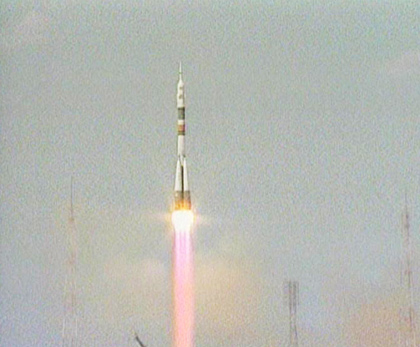Rocket Blasts Off to Double Space Station Crew

Thisstory was updated at 8:06 a.m. EDT.
A RussianSoyuz rocket blasted off Wednesday carrying three spaceflyers from threedifferent countries on a mission to double the population of the InternationalSpace Station.
The Soyuzrocket launched at 6:34 a.m. EDT (1034 GMT) from Baikonur Cosmodrome inKazakhstan carrying the Russian-built Soyuz TMA-15 spacecraft and three peopleaboard set to make history as part of the space station?s first fullsix-person crew. It was about 4:34 p.m. local time at the Central Asianspaceport.
?Feelingwell onboard, systems in order,? said Soyuz commander Roman Romanenko, the sonof veteran cosmonaut Yuri Romanenko, just after launch. ?It?s just likeflying.?
Romanenko launchedinto space alongside Canadian astronaut Robert Thirsk and Belgianspaceflyer Frank De Winne, who represents the European Space Agency. They aredue to dock at the space station on Friday at 8:34 a.m. EDT (1234 GMT), wherethree other spaceflyers representing Russia, the U.S. and Japan await theirarrival.
?We are aninternational crew in an International Space Station and I think this is astrength,? De Winne said in a televised press conference before launch. ?Tomaintain six people in a station by one single nation today, I think that wouldbe impossible.?
The $100billion orbital lab is the product of cooperation between the U.S., Russia,Canada, Japan and 11 countries in the European Space Agency. Doubling its crewsize will boost the amount of science and maintenance performed aboard, the spaceflyerssaid.
Breaking space news, the latest updates on rocket launches, skywatching events and more!
Station?sfirst full crew
Romanenko,De Winne and Thirsk are the secondwave of the space station?s first-ever full six-person mission - Expedition20 - which will begin Friday when their Soyuz TMA-15 spacecraft arrives at theorbiting laboratory.
Constructionof the space station began in 1998 with the launch of its first piece, theRussian-built Zarya control module. The first crew - a small, three-man team -took up residence in 2000 after a U.S. connecting node and Russian crewquarters were installed.
AfterNASA?s tragic 2003 Columbia disaster, the station?s crew size dipped to onlytwo people - an American and a Russian - until the U.S. space shuttle fleetresumed flight two years later. By 2006, the station had returned tothree-person crews and now, after more than 10 years of construction, the spacestation has the internal living space of a jumbo jet.
?One of ourgoals with our three colleagues on orbit is to prove that the station cansupport six people for long duration,? Thirsk said.
The spacestation is currently home to veteran Russian cosmonaut Gennady Padalka - theoutpost?s first two-time commander - as well American Michael Barratt andJapanese astronaut Koichi Wakata, both flight engineers. Together, they make upthe space station?s Expedition 19 crew, though that name will give way toExpedition 20 on Friday.
Since theirmission began in late March, the Expedition 19 crew has been putting the finaltouches on the station?s life support systems that will support six people inspace.
Last week,they officially activated the space station?s urinerecycling system, which filters and converts astronaut urine back intopotable water fit for drinking, bathing, food preparation and oxygengeneration.
Padalkawill command Expedition 20 once it begins, then hand over control of thestation to De Winne - Europe?s first station commander - when he and Barrattreturn to Earth in the fall.
ScienceGets Boost
One of themajor goals for doubling the space station?s crew is to increase the amountof science performed aboard the orbiting lab. With twice as many people onboard, the station crew should be able to nearly triple the number ofexperiments performed in a given mission, mission managers said before flight.
?Thesix-person crew is a milestone for the International Space Station,? Thirsksaid before flight. ?In a big way, the International Space Station will be ableto fulfill its primary purpose, which is to function as a world class orbiting laboratoryfor medical science and materials science.?
Scienceforms only part of a packed mission for the expanded space station crew.
Next month,the spaceflyers plan to perform two spacewalks in as many weeks to prepare thestation for the arrival of a new Russian module. They will also host the firstof two planned NASA shuttle missions to continue construction of the orbitinglab.
The Juneflight will temporarily boost the number of people at the station to 13 - themost ever - and will deliver the last piece of the station?s massiveJapanese-built Kibo lab. Another shuttle flight in August will delivermuch-needed supplies and equipment. Eight more spacewalks are on tap duringthose shuttle visits.
The stationcrew will end the summer with the planned arrival of Japan?s first unmannedcargo ship, the H-2 Transfer Vehicle.
?On ourcrew, we have a lot of fun, but we also work very hard,? De Winne said. ?So I thinkwhatever we do ? will be the lead for future space exploration in our solarsystem.?
- New Video - Drink Up! Astronauts Toast With Recycled Urine
- Video Show - The ISS: Foothold on Forever
- New Video - Tour the Space Station's Bathroom

Tariq is the award-winning Editor-in-Chief of Space.com and joined the team in 2001. He covers human spaceflight, as well as skywatching and entertainment. He became Space.com's Editor-in-Chief in 2019. Before joining Space.com, Tariq was a staff reporter for The Los Angeles Times covering education and city beats in La Habra, Fullerton and Huntington Beach. He's a recipient of the 2022 Harry Kolcum Award for excellence in space reporting and the 2025 Space Pioneer Award from the National Space Society. He is an Eagle Scout and Space Camp alum with journalism degrees from the USC and NYU. You can find Tariq at Space.com and as the co-host to the This Week In Space podcast on the TWiT network. To see his latest project, you can follow Tariq on Twitter @tariqjmalik.
